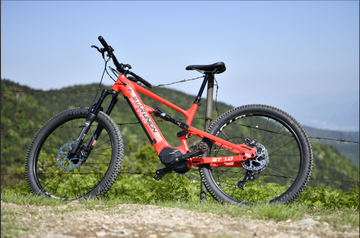The Varying Demands of Hydraulic Disc Brakes Across Different Types of Bicycles
by YunaLi on Apr 21, 2025

As cycling technology continues to evolve, hydraulic disc brakes have become the go-to choice for many cycling enthusiasts and professional riders. They offer enhanced braking power and an overall better riding experience. However, the demand for hydraulic disc brakes varies depending on the type of bicycle. Understanding these differences is essential when choosing a brake system, whether you're purchasing a new bike or upgrading an existing one. In this blog post, we’ll explore the varying demands of hydraulic disc brakes across different types of bicycles.

1. Mountain Bikes (MTB)
Mountain bikes are designed to handle rough and challenging terrains, such as steep descents, mud, and rocky trails. Hydraulic disc brakes are especially crucial in these conditions, as they provide strong stopping power, ensuring stability during downhill rides, sharp turns, or emergency stops.
Demand Characteristics: Mountain bikes typically require high braking power. Hydraulic disc brakes offer significantly better stopping force compared to mechanical disc brakes or rim brakes, especially in wet or muddy conditions.
Advantages: Hydraulic disc brakes are known for their durability and require less maintenance, making them ideal for long, rugged rides over complex terrain.
2. Road Bikes
Road bikes are often used for fast riding and long-distance cycling on smooth, paved roads. While the braking demands of road bikes may not be as high as mountain bikes, many riders still prefer hydraulic disc brakes, particularly those seeking precision and comfort.
Demand Characteristics: For road bikes, hydraulic disc brakes primarily serve to enhance braking precision and responsiveness, particularly on downhill sections. Modern road bikes are usually lightweight, so hydraulic disc brakes offer strong stopping power without adding significant weight.
Advantages: Hydraulic disc brakes provide a smoother braking experience with less maintenance, ensuring a comfortable and controlled ride over long distances.
3. Gravel Bikes
Gravel bikes combine elements of mountain and road bikes, designed for mixed terrains such as unpaved roads and light off-road riding. Just like mountain bikes, gravel bikes require hydraulic disc brakes for strong, consistent braking performance on challenging surfaces.
Demand Characteristics: Gravel bikes often encounter rough surfaces like mud, sand, and gravel, which demand a braking system that can perform reliably in these conditions. Hydraulic disc brakes deliver consistent braking power, even on slippery or uneven ground.
Advantages: Hydraulic disc brakes ensure stable braking in all conditions, offering better control and safety when navigating varied terrain.
4. Commuter Bikes
Commuter bikes are built for daily, urban cycling, typically on paved roads. While the braking demands are not as extreme as those of mountain or gravel bikes, hydraulic disc brakes are still a preferred option for many urban cyclists, especially those who ride in unpredictable weather.
Demand Characteristics: Although commuting often takes place on flat surfaces, hydraulic disc brakes are highly effective in challenging weather conditions, such as rain or wet roads, providing reliable braking when it's most needed.
Advantages: Hydraulic disc brakes reduce wear on the wheels, require less maintenance, and enhance the overall riding experience, particularly when quick, reliable stopping is necessary in city traffic.

5. Hybrid Bikes
Hybrid bikes offer a blend of road and mountain bike features, designed to handle both paved roads and light off-road trails. Hydraulic disc brakes are an excellent choice for hybrid bikes, as they allow cyclists to enjoy a smooth ride regardless of the terrain.
Demand Characteristics: Hybrid bikes are used in diverse environments, so hydraulic disc brakes are perfect for riders who encounter everything from smooth pavement to gravel roads. The braking system needs to perform reliably across a variety of surfaces.
Advantages: Hydraulic disc brakes provide smooth, precise stopping power, ensuring a comfortable and safe ride on mixed terrain.
Conclusion
The demand for hydraulic disc brakes varies significantly across different types of bicycles. From mountain bikes to road bikes, gravel bikes, commuter bikes, and hybrid bikes, hydraulic disc brakes stand out for their superior stopping power and adaptability. Whether you're looking for a bike to conquer tough trails or one that offers a smooth, controlled ride in the city, hydraulic disc brakes provide the safety and comfort you need.
If you're in the market for a new bike or considering upgrading your existing setup, be sure to take your riding environment, terrain, and personal needs into account. Hydraulic disc brakes are an excellent investment for any cyclist seeking reliable, high-performance braking.



